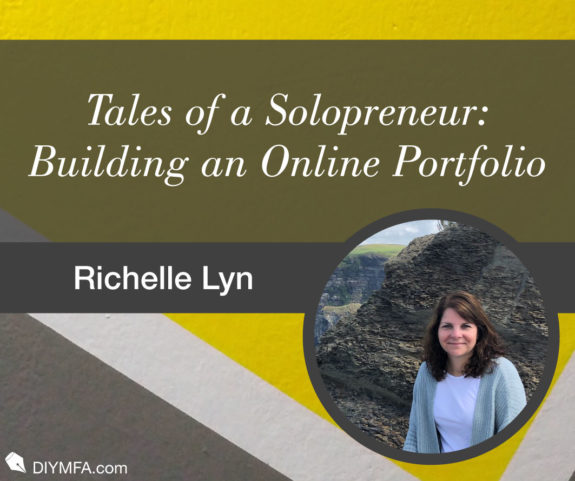Disclaimer: DIY MFA does not provide legal, tax accounting, or financial advice. In making decisions regarding whether to hire a domain name broker, purchase a domain name, or other decisions that may have legal and/or financial ramifications. In making these and other decisions related to building your online portfolio, we strongly urge you to speak to a licensed attorney or financial adviser in your specific jurisdiction for the most accurate information.
In my last post, I discussed my experience as a small business owner (“SBO”) in deciding whether to trademark my small business, selecting a business name, and preparing and filing a trademark application. As part of this process, I discovered first-hand the importance of claiming your business name sooner than later. It also made me appreciate the importance of thinking ahead to future business opportunities to save myself from unforeseen challenges and unnecessary expenses later.
This Tales of a Solopreneur installment discusses the steps I’ve taken as an SBO to build an online portfolio that protects not only my formal business name, but also related and future business names and ideas.
Trademark applications are known to trigger people to pick up available domains and social media handles that are suspected to be important to the filer. I didn’t want to be blocked completely from using certain names or have my budget run-up unnecessarily because I didn’t act quick enough. So, I built my online portfolio before I filed my trademark application, but this step would be equally important before launching any business.
Deep Diving into ALL of The Names
I started out wide by researching names and narrowed it down from there.
Brainstorming Names
I brainstormed and made a list of various iterations of the business name I planned to use, including shortened versions, longer versions, acronyms, different spellings, and related names. I also brainstormed similar iterations of names or ideas that I might want to use in the future—both for business services as well as for my personal and author brand usage.
Researching Domain Names
I researched the domain names for each name on the list to see which domains were available. I used the Google Domains search feature which is quick and easy and provides the availability of various endings for the searched name (e.g., .com, .net, .org, etc.), the cost to purchase each domain ending, and other name iterations to consider. I took notes as I went to make it easier to evaluate later.
Checking Social Media
I researched these same names on the primary social media platforms I planned to use to reach my target audience to see which handles were available and would be most valuable to me.
Reviewing and Ranking the Results
Then I reviewed my notes and ranked the level of ease of using each name:
- 1 meant both domain and primary handles available,
- 2 meant one or the other was taken, and
- 3 meant both taken.
I made a list of the 1s and ranked them in descending order from most important or desired to least. I also made a similar list with the 2s.
Slipping Down the Rabbit Hole
Next, I analyzed the lists of 1s and 2s to determine if I had some viable names to work with. The 1s were clear cut—I wanted them, or I didn’t.
The 2s required more energy. If the domain was available, did it matter that the primary handles weren’t? If the domain wasn’t available, how was it being used?
I also double-checked the 3s to make sure none of those names were going to cause an issue for me. If that had been the case, I would have done some additional analysis to figure out how to build a workaround if I didn’t have viable options under 1 and 2.
As you may remember, I had already selected my main business name because of specific circumstances. If I hadn’t already done this, making sure my business name was available would have been key in this process.
In my case, my business name was a 1 (yay!), but my acronym was a 2 because the .com domain name had previously been purchased (boo!); and I was focused on .com endings for my domains.
But, when I checked out the website to see if this website might cause me some heartburn down the road, I discovered the website wasn’t actually in use.
So, I jumped back over to Google Domains to rerun the name search and see what I could find out about the owner. This can be done by clicking on the box with the desired ending and then clicking Find Out Who Owns This Domain. In my case, I could see the domain name had been purchased a long time ago, so I thought it might be worth checking to see if the owner would sell the name at a reasonable price.
Hiring a Domain Name Broker
Domain name brokers negotiate a domain name purchase from soup to nuts while protecting your identity, so it’s more difficult for the owner to run up the price based on your suspected level of interest. The broker can:
- Identify the owner and how the name is being used,
- Estimate the fair market value price range for the domain name,
- Contact the owner to determine their circumstances and if the name is for sale,
- Handle all of the communications and negotiations, and
- Complete the purchase and digital transfer of the ownership.
If you consider hiring a domain broker, ask for recommendations to make sure you’re working with a reputable broker. You should also be clear before you start how the broker earns compensation and at what point you have to start paying for services. This will help you determine if initiating discussions makes sense based on your budget. For example:
- Is the broker’s research on the domain owner and availability and/or initial outreach to the owner complimentary?
- What is the fee formula (e.g., flat, hourly, other) and basis (e.g., does the broker get paid regardless of results)?
- When are payments due (e.g., upfront, in installments, at the end)?
Many SBOs only budget for the annual registration fee for their domain name(s), so the additional costs to purchase a domain name already owned is often cost-prohibitive.
Each SBO who desires to purchase a domain out of circulation must do a facts and circumstances review to weigh their costs and benefits. Sometimes a bit of short-term pain for the wallet may be worth the long-term gain for a business, but usually, a broker’s expertise is needed to determine if this might be the case. I discovered this was the case for me.
I ultimately hired a broker recommended to me by my IP lawyer. In my case, a partnership had purchased the domain name I was interested in years earlier; but after its own name changed due to the exit of a partner, they discontinued use of the domain. So the owner had a domain they didn’t need and an interested buyer.
My broker negotiated a purchase price that was significantly less than the owner’s initial offer—and less than I had budgeted for based on the broker’s initial price estimate. My broker charged me a fee that I considered to be very reasonable for his services, even before taking into consideration how much money he saved me. Plus, he made the whole purchase process totally painless for me.
Building an Online Portfolio
While my broker was negotiating the domain name purchase, I continued my name rankings process and created a final list of the available names that I wanted to protect for both my business and personal platforms.
Although I had no plans to actively use many of these names, I didn’t want anyone else to prevent me from using their domains and handles later. I also didn’t want anyone else to benefit from using names that were similar enough to the brand I planned to build over the long-term.
So, I decided to purchase the domain names for all of the names on my list since they were only $12/year to start with, which I viewed as a small price to pay for the long-term protection and flexibility.
Then I spent many hours at my computer methodically purchasing domain names, signing up for email addresses, and claiming handles on social media platforms for every last one of the names on my final list.
It wasn’t fun, but it was important for me to do for my online portfolio. I also kept a detailed list of everything I purchased and signed up for, so I can easily remind myself what’s already in my online portfolio as I expand my business in the coming years.
What’s Up Next?
The online portfolio step is making me feel like I’m a spider building a very large web. Each new task sends me out to build a strand of my web with me returning back to the center when I’m done, so I can start building a new strand another day.
One of those strands is building my first website—a task I’ve been successful at productively procrastinating on for a while, which leads me to believe that some interesting realizations are ahead for me that I look forward to sharing with you.
In the meantime, I hope you are following your own solopreneur path of discovery. I would love to hear more about it.
Tell us in the comments: How have you been building your online portfolio?

Richelle Lyn is a compensation & benefits attorney and HR executive, who now spends her days focused on the writing life. Her favorite fiction reads involve leading ladies who push boundaries and conquer their fears while preferably digging for secrets, learning magic, and/or saving the World. She’s also a fan of non-fiction reads focused on personal growth and transformation. She loves her tea hot and her coffee iced. She calls South Florida home, but her favorite place to be is on a trip. You can check her out on Twitter and Instagram.







